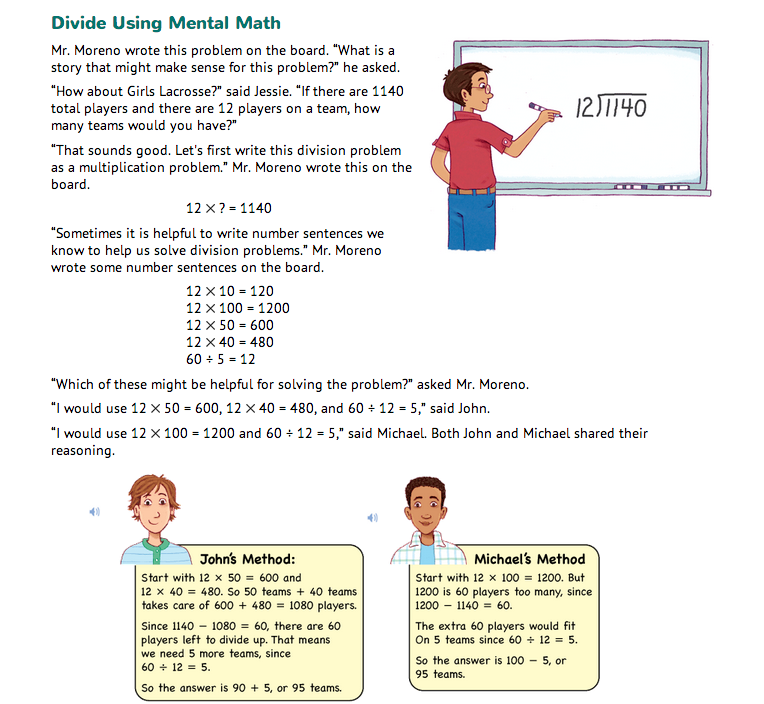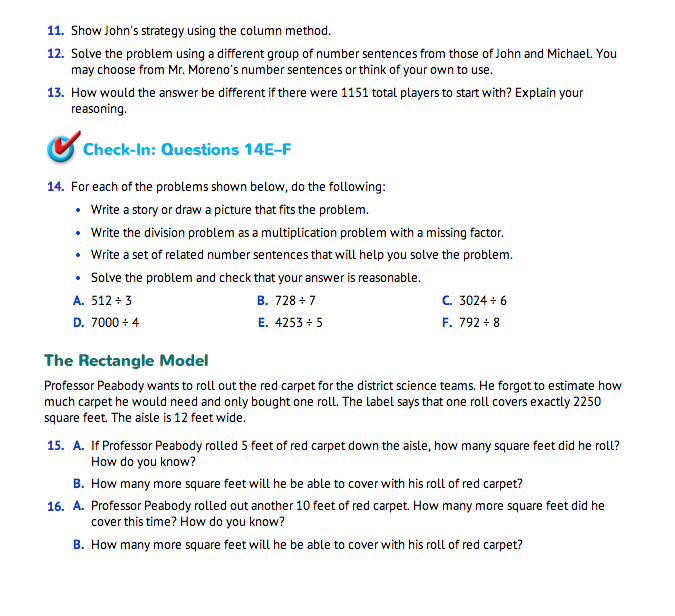Modeling Division
Est. Class Sessions: 2–3Developing the Lesson
Part 3. Divide Using Mental Math
Begin this part of the lesson by reading and discussing the vignette in the Divide Using Mental Math section in the Student Guide. Two sample solutions using a cluster of related number sentences are discussed for the problem 1140 ÷ 12. Ask students to read through John's and Michael's strategies with a partner. Then ask them to explain one of the boy's strategies to their partners in their own words.
Write the following on the board or a display:
712 ÷ 8
Have students work in pairs to write a story or situation that matches this division problem. Choose one of the stories to use as the context for the problem.
The following is an example:
We will refer to this example throughout the discussion. The story you use in your class may be different.
Ask:
Write the number sentences on the board or a display as students say them. If these number sentences do not come up, add them to the list:
8 × 9 = 72
8 × 8 = 64
8 × 80 = 640
8 × 90 = 720
800 ÷ 8 = 100
88 ÷ 8 = 11
Ask students to solve the problem with a partner using the number sentences on the list. Have each pair of students record their strategies. Have two or three pairs of students share their strategies with the whole class. The Sample Dialog shows a possible discussion with students as they explain their mental math strategies.
After students have practiced using related number sentences to solve the division problem posed and had the opportunity to discuss their mental math strategies, direct their attention back to the Student Guide. Have students work on Questions 11–13 which revisit the problem Mr. Moreno and Jessie posed of dividing players into teams. In Question 12, students solve the problem using a different set of related facts.
Question 13 relates to students' understanding of the remainder within the context of the problem. Dividing 1151 total players into teams of 12 each results in the same quotient of 95 teams, but there is now a remainder of 11 players. Use the remainder that occurs in Question 13 to review the term remainder. Write the word on the board, explaining that when the leftover amount is less than the divisor, we cannot divide any further and still get a whole number answer. Use the word remainder in place of leftover so students become used to the term.
In Question 14, students invent situations to represent division problems. This helps students make meaning of division and provides a context for checking the reasonableness of their answers. Students then write each division problem as a multiplication sentence and use related number sentences to help them solve the problem.
Assign student pairs to complete problems in Questions 14A–D in the Student Guide. Select one or two problems to discuss with the whole class. Ask students to share their stories for the problem, their solutions, and their reasoning. Have several students share different methods for solving the same problem. This will expose students to varied and flexible ways to divide mentally, and it may uncover simpler, more efficient methods for students who are struggling with using mental math to divide.
Ask:
Assign Check-In: Questions 14E–F for students to complete independently. Students invent situations to represent division problems, write each division problem as a multiplication sentence and use related number sentences to help solve the problem. Through this exercise, students estimate quotients for the division of multidigit numbers by one- and two-digit numbers using clusters of related problems.















